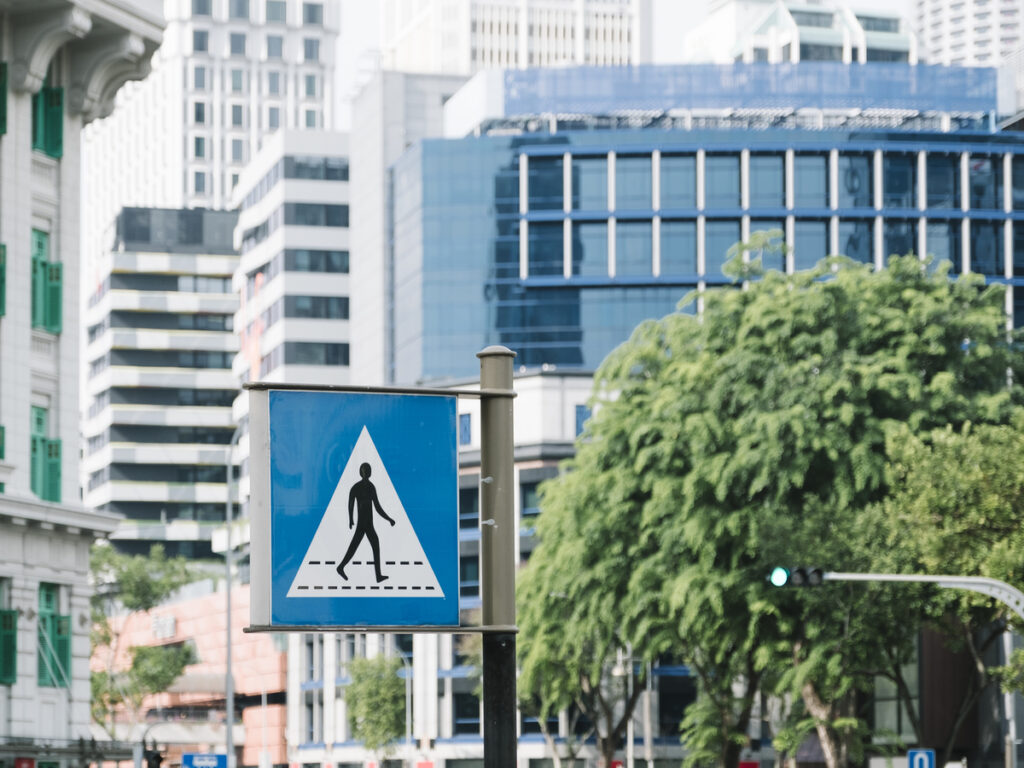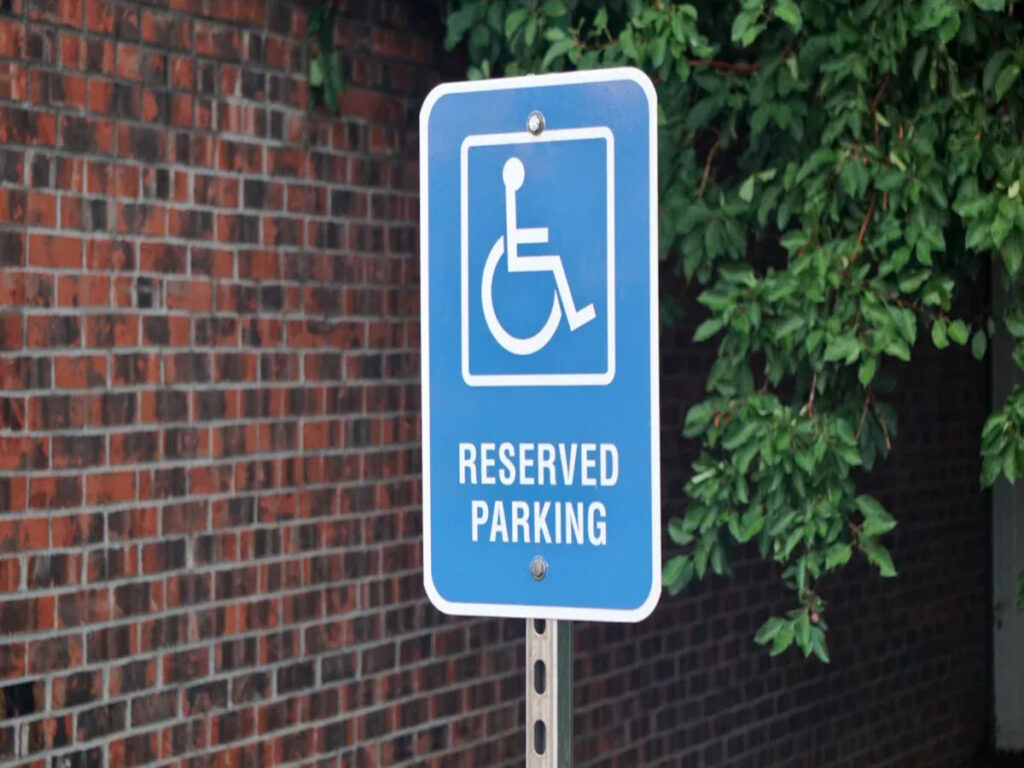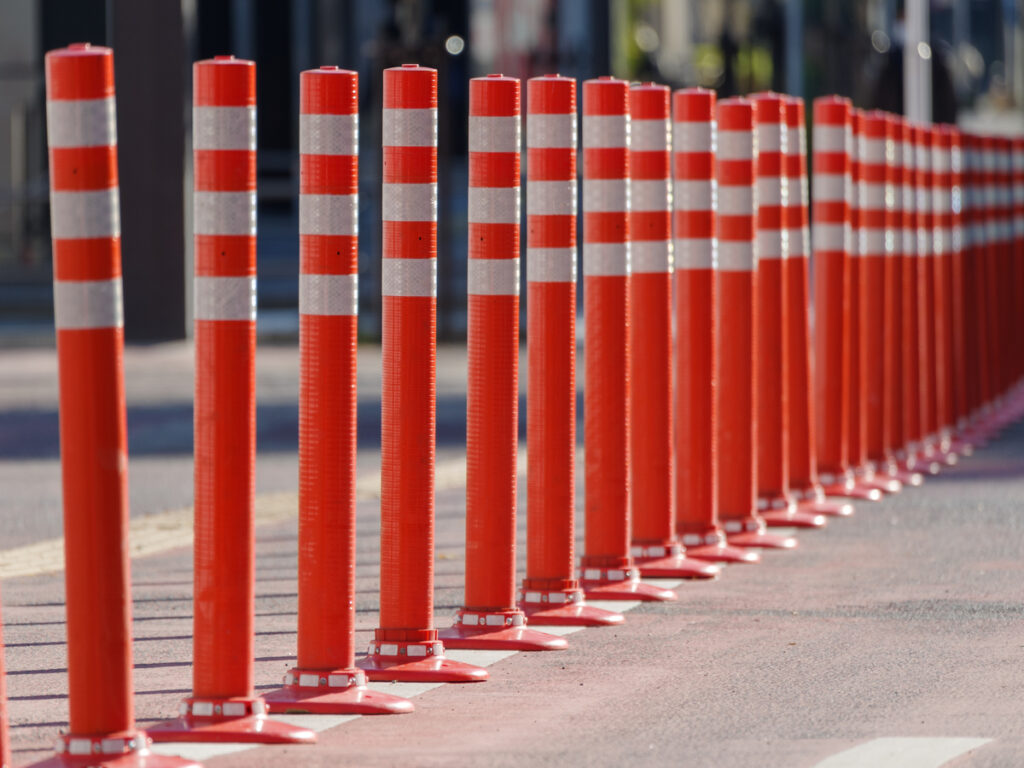
Choosing the right bollard material is very important for safety. Plastic traffic bollards are light and easy to install. Ils travaillent bien dans les parcs, quartiers, or places with slow traffic. Steel bollards are strong and provide better protection in risky areas. They are great where crashes might happen. Both types have different uses. Knowing their benefits helps you pick the right one.
OPTRAFIC offers a wide selection of Bollards de la circulation Pour répondre aux besoins spécifiques, including strong steel bollards for high-risk areas and lightweight plastic bollards for lower-traffic zones. With an emphasis on safety, durabilité, et facilité d'installation, OPTRAFFIC provides solutions designed to improve traffic management and pedestrian safety.
Principaux à retenir
- Plastic traffic bollards are light and simple to set up. They work well for short-term use in safe places like parks or neighborhoods.
- Bright colors and shiny strips on plastic bollards make them easy to see. This helps keep people and drivers safe, especially in busy or dark areas.
- In places with lots of traffic or high security, steel bollards are better. They are stronger and last longer in bad weather.
- Using both plastic and steel bollards together can make areas safer. Plastic can guide traffic, while steel can protect important spots.
- Picking the right bollard type for each area keeps it safe and useful.
Advantages of Plastic Traffic Bollards
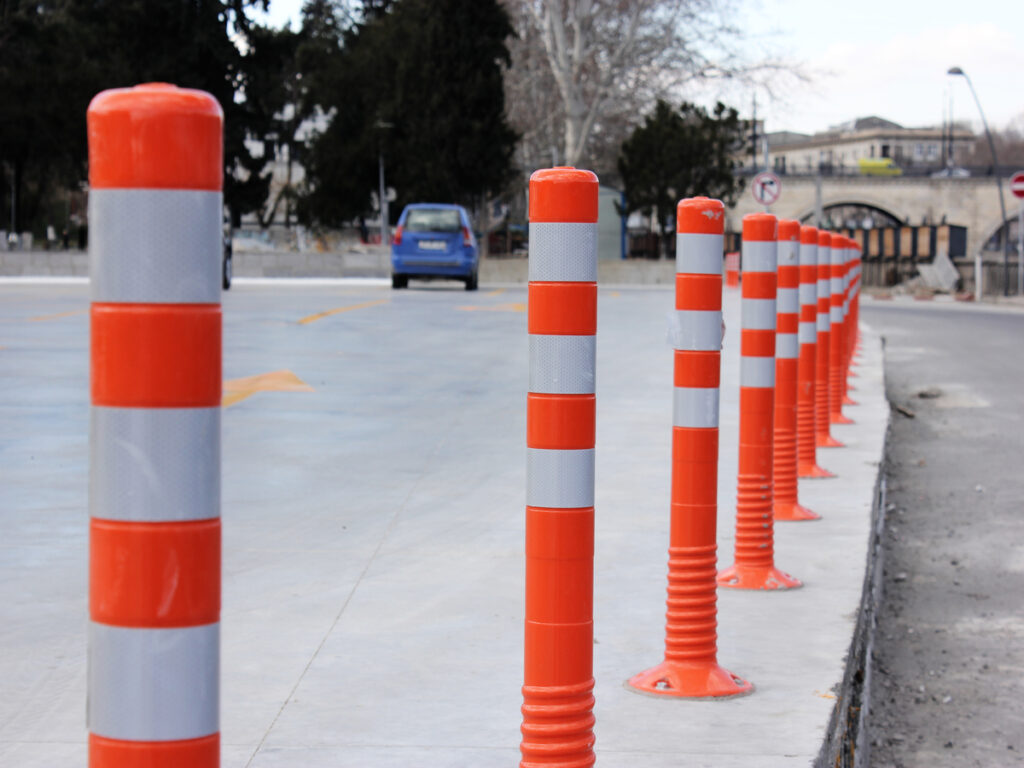
Lightweight Design for Easy Use
Plastic bollards are very light and simple to move. Unlike heavy ones, they don’t need special tools to set up. You can quickly place them for events or roadwork. They are easy to adjust, helping manage traffic better.
Parce qu'ils sont légers, they are safer to handle. You can move them without much effort. This is helpful when changes are needed often. Their ease of use makes them great for short-term or low-risk needs.
Affordable Option for Temporary Needs
Plastic bollards are a cheap way to manage traffic safely. The market for temporary bollards may reach $4 milliards dans 2023. It’s growing by about 5.6% each year due to high demand. People use them in construction zones and at events.
Their low cost lets you buy many without overspending. Par exemple, you can use lots of them during festivals or roadwork. This helps keep people safe while staying within budget.
Bright Colors for Better Safety
Plastic bollards are made to be easy to see. They are brightly colored and often have reflective strips. This makes them visible even at night or in dim light. Drivers and walkers can spot them easily, Éviter les accidents.
This visibility is key in busy areas or at night. Par exemple, they guide people safely in parking lots or school zones. Adding colorful covers makes them stand out even more.
Using bright plastic bollards keeps everyone safer. They grab attention and help manage traffic in any setting.
Flexible and Safe for Low-Risk Areas
Plastic bollards work well in places with low risks. These areas need tools that can change easily but stay safe. Plastic bollards are made to bend if lightly bumped, not break.
This bending helps protect both cars and the traffic bollards. Par exemple, if a car taps a plastic bollard, it bends and springs back. This stops damage to the car and keeps the bollard usable. Harder materials might scratch or dent cars, ça coûte plus cher à réparer.
Plastic bollards are also great for places that need quick changes. Think of an event where traffic setups change every day. You can move these bollards easily without damaging them. Their light weight makes them simple to adjust as needed.
They also handle small weather problems well. While not for harsh weather, they work fine in mild conditions. They don’t crack or break easily, making them good for parks, écoles, or walkways.
Ideal Use Cases for Plastic Bollards
Parking Lot Guidance and Pedestrian Pathways
Plastic bollards are great for parking lots and walkways. Ils sont légers et faciles à déplacer. Leurs couleurs vives et leurs bandes réfléchissantes les rendent faciles à voir. Drivers can follow them, and pedestrians stay safe. Use them to mark lanes or guide traffic.
In cities like Doha, Qatar, they help reduce traffic jams. They also improve safety in busy areas. Flexible designs allow quick setup and changes. This makes them perfect for parking lots or crowded spaces. Bollards create safer places for cars and people.
Temporary Traffic Control in Construction Zones
Construction zones need tools that are easy to adjust. Plastic bollards work well for these areas. They are light and simple to move as work changes. Use them to block lanes or warn about danger.
If a car hits them, they bend instead of breaking. This protects cars and workers from damage. À Riyad, Arabie Saoudite, they were used during big events. They helped guide people and keep cars out of restricted areas. Plastic bollards are great for temporary traffic setups.
Crowd and Event Management
Events often need barriers to manage people and cars. Plastic bollards are helpful for this. Ils sont faciles à transporter et à installer rapidement. Use them to separate walking areas from driving zones.
Event planners use them to keep things organized and safe. Their bright colors help people find their way easily. Whether it’s a festival or sports event, bollards keep crowds under control. They make spaces safer for everyone.
School Zones and Low-Speed Areas
Plastic traffic bollards work well in school zones and slow areas. These places need tools that focus on safety and visibility. Use plastic bollards to separate cars from people walking. Leurs couleurs vives et leurs bandes réfléchissantes les rendent faciles à voir. This is helpful during mornings or evenings when it’s darker.
Dans les zones scolaires, kids often walk near or cross streets. Plastic bollards guide drivers and remind them to drive slower. Place them near crosswalks, drop-off spots, or playground gates. This helps drivers stay careful and keep speeds low.
Slow-speed areas like neighborhoods or parks also need traffic safety bollards. These places often have narrow roads or shared spaces. Bollards show drivers where to go and stop risky moves.
Conseil: Add school logos or fun designs to bollards for kids. This makes them more interesting while keeping everyone safe.
Plastic bollards are light and simple to move around. This makes them great for temporary use, like during school events or repairs. You can quickly change their spots as needed.
They also bend if a car hits them by accident. Unlike hard barriers, they spring back into shape. This avoids damage to both the car and the bollard.
Using plastic bollards in school zones and slow areas keeps everyone safer. Ils sont bon marché, facile à voir, et simple à utiliser, En faire un choix intelligent.
Limitations of Plastic Traffic Bollards
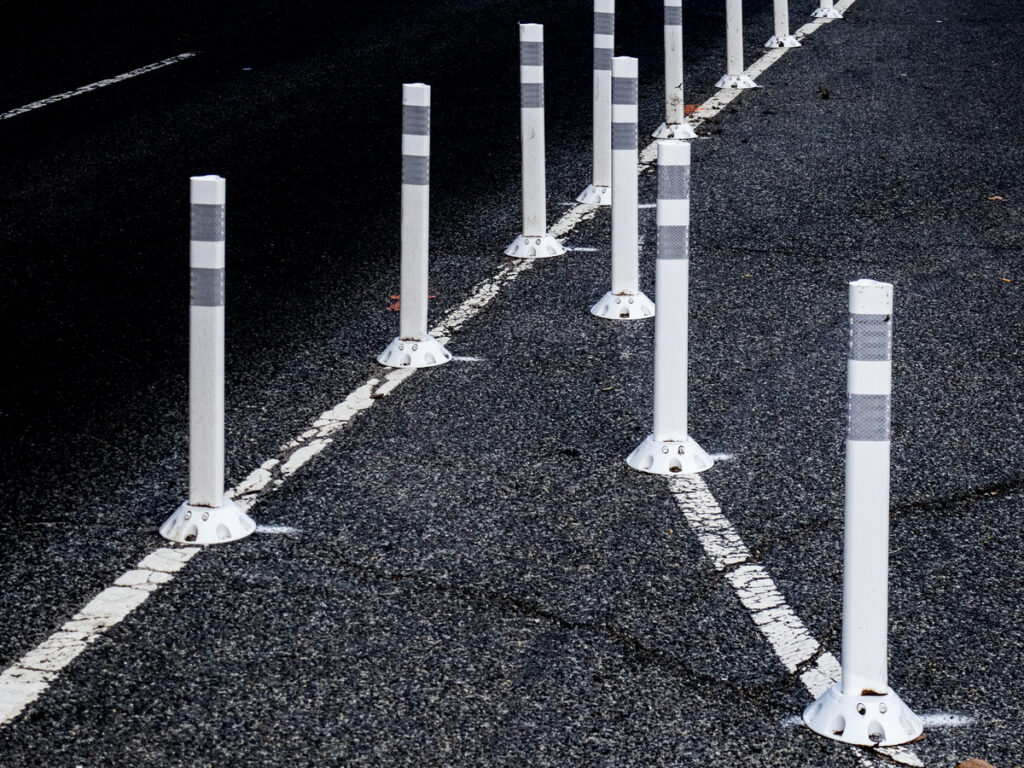
Weak in High-Impact Situations
Plastic bollards can’t handle strong crashes. If a car hits one, it might bend or break easily. This makes them bad for places with fast-moving traffic. Highways or busy intersections need tougher barriers to keep people safe.
Plastic bollards work fine in low-risk areas. But they fail in high-impact zones. Their light design is useful but not strong enough for heavy vehicles. If you need barriers that block cars completely, plastic ones won’t work.
Not Good for High-Security Areas
Plastic bollards aren’t strong enough for secure places. Locations like embassies or banks need barriers that stop cars during crashes. Steel or concrete bollards are better for these needs.
If you want to protect important buildings, plastic bollards won’t help. They can’t stop cars from breaking through. Pour une sécurité maximale, use materials that resist strong impacts.
Struggle in Harsh Weather
Plastic bollards don’t do well in bad weather. Hot sun, forte pluie, or freezing cold can weaken them. Rayons UV can make them fade or crack, reducing their usefulness.
In places with tough weather, plastic bollards may not last long. Strong winds or snow can move them, les rendre peu fiables. For long-term use in rough climates, steel or other strong materials are better.
Note: Plastic bollards are cheap and flexible but not for tough jobs. Use stronger materials for high-impact, sécurisé, or extreme weather areas. Match the bollard type to the location for best results.
When to Upgrade to Steel Bollards
High-Traffic Areas Needing Strong Protection
Busy areas have more chances of car crashes. Steel bollards are tough and protect people and property. They can handle hits from fast-moving cars. This makes them perfect for highways, intersections, and crowded city streets.
Steel bollards stop cars from entering pedestrian zones or restricted spaces. They stay strong even after crashes, Garder les gens en sécurité. Par exemple, crash-rated bollards are used in places with heavy traffic to reduce damage during accidents.
If your area has lots of cars, steel bollards are better. They provide safety and last longer, Économiser de l'argent sur les remplacements.
Storefront Safety from Vehicle Damage
Storefronts near busy roads face risks from cars. Steel bollards protect these spaces from accidental or planned crashes. They create a safe zone, keeping cars away from walkways and buildings.
Steel pipe bollards are great for protecting store entrances and glass windows. They keep customers and workers safe. For big businesses, they add extra security against threats.
- Steel bollards block cars from entering restricted areas.
- They make walkways safer by stopping vehicle access.
- They protect storefronts from damage caused by cars.
If you own a store, steel bollards keep your space safe. They are strong and reliable for protecting commercial areas.
Security for Important Buildings
Places like government offices and embassies need strong barriers. Steel bollards stop cars and trucks from crashing into these spaces. They are great for protecting high-risk areas from accidents or attacks.
Steel bollards take up little space, making them good for cities. They can match the look of the area while providing safety.
- Used near entrances, parkings, and key spots of government buildings.
- Protect public spaces, magasins, and high-security areas.
- Stainless steel bollards keep walkways and bike paths safe.
For sensitive places, crash-resistant bollards are the best choice. They protect without ruining the area’s appearance. Steel bollards help secure important buildings and keep people safe.
Long-Term Strength in Tough Conditions
Steel traffic bollards are the best for lasting many years. They are strong and work well in places needing durability. Contrairement aux autres matériaux, steel handles daily use, intempéries, and small crashes without damage.
Steel bollards stay tough in extreme weather. They don’t weaken in heat, pluie, or freezing cold. Par exemple, in coastal areas, coated steel bollards resist salt damage. This keeps them useful and looking good for a long time.
In risky areas, crash-resistant bollards stop cars during accidents. They protect people and property by staying strong after impacts. This makes them great for busy streets, parkings, et les espaces publics.
Crash-rated bollards also help with security. Use them to block cars from entering important places like airports or banks. Their strong build keeps people and buildings safe from harm.
Steel bollards need little maintenance. Une fois installé, they last a long time without repairs. This saves money since you won’t need to replace them often. They are a smart choice for projects needing lasting safety.
If your area has tough conditions, steel bollards are perfect. Ils gèrent le mauvais temps, plantage, and security needs, making them a reliable safety tool.
Integrating Plastic and Steel Bollards for Complete Safety
Using Plastic Bollards for Traffic and Visibility
Plastic traffic bollards help guide traffic and improve visibility. Leurs couleurs vives et leurs bandes réfléchissantes les rendent faciles à voir. Utilisez-les dans les parkings, zones de construction, ou espaces d'événements. Ils sont légers, so you can set them up quickly. This makes them great for temporary use.
In places where traffic changes often, plastic bollards are useful. Par exemple, during a festival, they can create lanes or walkways. If a car lightly hits them, they bend instead of breaking. This keeps them working and avoids damage to cars. They are a smart choice for low-risk traffic control.
Using Steel Bollards for Protection and Security
Steel bollards are strong and last a long time. They are perfect for places needing crash protection. They protect people, bâtiments, and other things from accidents. You’ll see them near stores, bâtiments du gouvernement, et les rues animées.
Steel bollards also keep vehicles out of secure areas. Par exemple, they block cars from entering pedestrian zones or important places. Ils restent forts même par mauvais temps, les rendre fiables. Steel bollards provide safety that plastic ones cannot match.
Combining Plastic and Steel Bollards
Using both plastic and steel bollards creates better safety. Plastic bollards guide traffic and improve visibility. Steel bollards handle crashes and protect secure areas. Ensemble, they work well in many situations.
Par exemple, sur un chantier, plastic bollards can guide cars through detours. Steel bollards can protect workers and equipment from crashes. Dans une ville, plastic bollards can mark walkways, while steel bollards protect stores and public spaces.
This mix of materials gives you the best of both worlds. Each type is used where it works best, creating a safer and more effective solution.
Plastic bollards are useful in places with low risks. Ils sont légers et pliables, perfect for short-term use. They are cheap and help manage traffic while being easy to see.
Steel bollards are strong and work well in dangerous areas. They stay tough during crashes and bad weather. This makes them a good choice for long-lasting safety.
Pick the right bollard based on what you need. Using the right type ensures safety and works best for the job.
FAQ
Will a plastic bollard break if a car hits it?
Non, plastic bollards bend when lightly hit by a car. They quickly return to their shape, avoiding damage to cars or the bollard. But they are not made for fast or heavy crashes.
Can you use plastic bollards for permanent installations?
Plastic bollards are best for short-term or low-risk uses. For permanent setups in busy or secure areas, steel bollards are stronger and last longer.
Are plastic bollards crash-rated?
Non, plastic bollards are not crash-rated. They are made to be seen and handle small bumps. For places needing strong crash protection, steel or concrete bollards are better.
How do you maintain plastic bollards?
Plastic bollards are easy to care for. Wash them with soap and water to keep them clean. Keep them out of harsh weather to make them last longer.
Can plastic and steel bollards be used together?
Oui, using both types improves safety. Plastic bollards guide traffic and are easy to see. Steel bollards protect against crashes and secure risky areas.

